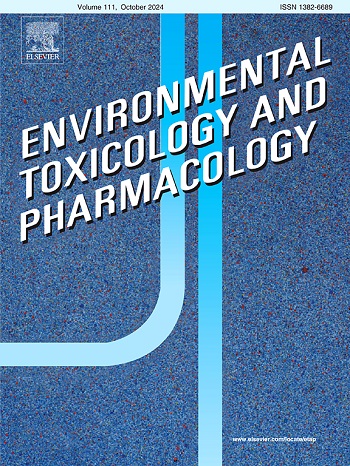新烟碱和杀真菌剂的混合物影响蜜蜂的觅食活动。
IF 4.2
3区 环境科学与生态学
Q2 ENVIRONMENTAL SCIENCES
引用次数: 0
摘要
植物保护产品(PPPs)的使用是导致全球昆虫数量下降的一个主要因素。在此,我们以蜜蜂(Apis mellifera)为模型,利用射频识别技术研究欧盟最后一种新烟碱(啶虫脒)和不同杀菌剂对蜜蜂觅食飞行的综合影响。与对照组和每种杀虫剂的单独作用相比,抑制甾醇生物合成的杀菌剂苯醚甲环唑和杀虫剂啶虫脒的混合物显著减少了每天的觅食次数,而杀虫剂与不抑制甾醇生物合成的杀菌剂啶虫脒/多菌灵的混合物则不影响行为。杀真菌剂/杀虫剂混合物的这种潜在协同作用支持了这样一种观点,即某些杀真菌剂可以增强杀虫剂的效果,而单独使用杀虫剂并不会导致行为发生显著变化。我们的研究结果表明,有必要对不同杀虫剂和杀螨剂的相互作用进行更多研究。本文章由计算机程序翻译,如有差异,请以英文原文为准。
Mixture of neonicotinoid and fungicide affects foraging activity of honeybees
The use of plant protection products (PPPs) is a major factor contributing to global insect decline. We here use the honeybee (Apis mellifera) as a model to study combined effects of the last neonicotinoid in the EU (acetamiprid) and different fungicides on live-long foraging flights using radio frequency identification. The mixture of the sterol-biosynthesis-inhibiting fungicide difenoconazole and the insecticide acetamiprid significantly reduced the number of foraging trips per day compared to the control and each PPP alone, while a mixture of the insecticide with the non-sterol-biosynthesis inhibiting fungicide boscalid/dimoxystrobin did not affect behaviour. This potential synergistic effect of the fungicide/insecticide mixture supports the notion that some fungicides can enhance the effect of insecticides, which did not lead to significant changes in behaviour when applied on their own. Our results emphasize the need for more studies on the interaction of different PPPs.
求助全文
通过发布文献求助,成功后即可免费获取论文全文。
去求助
来源期刊
CiteScore
7.00
自引率
4.70%
发文量
185
审稿时长
34 days
期刊介绍:
Environmental Toxicology and Pharmacology publishes the results of studies concerning toxic and pharmacological effects of (human and veterinary) drugs and of environmental contaminants in animals and man.
Areas of special interest are: molecular mechanisms of toxicity, biotransformation and toxicokinetics (including toxicokinetic modelling), molecular, biochemical and physiological mechanisms explaining differences in sensitivity between species and individuals, the characterisation of pathophysiological models and mechanisms involved in the development of effects and the identification of biological markers that can be used to study exposure and effects in man and animals.
In addition to full length papers, short communications, full-length reviews and mini-reviews, Environmental Toxicology and Pharmacology will publish in depth assessments of special problem areas. The latter publications may exceed the length of a full length paper three to fourfold. A basic requirement is that the assessments are made under the auspices of international groups of leading experts in the fields concerned. The information examined may either consist of data that were already published, or of new data that were obtained within the framework of collaborative research programmes. Provision is also made for the acceptance of minireviews on (classes of) compounds, toxicities or mechanisms, debating recent advances in rapidly developing fields that fall within the scope of the journal.

 求助内容:
求助内容: 应助结果提醒方式:
应助结果提醒方式:


